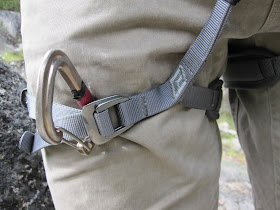I recently was shocked to find a somewhat major problem with my brand new harness. I bought a harness with "fast-buckle" systems. These systems have been around for five years or so, but are becoming an increasingly popular system on harnesses. The fast-buckle is essentially a system that allows you climb into your harness and tighten it up. You don't need to double it back or anything, once it's been tightened, it's supposedly good.
I've always been concerned that these harnesses might cause people to forget to double themselves back if they use a "normal" harness after using a fast-buckle for a period of time. But such a concern is nowhere near as disturbing as what I found when playing with my new fast-buckle harness.
I discovered that the leg-loop can actually unbuckle itself if you clip your rappel back-up friction-hitch directly into it near the buckle. See the following picture for what not to do with your carabiner on your leg-loop.
 Note the location of the carabiner on the buckle. If you actually had to use a rappel back-up
Note the location of the carabiner on the buckle. If you actually had to use a rappel back-upclipped to this carabiner, it could potentially cause the buckle to release. Do not do this.
The best thing to do with the friction-hitch back-up in order to avoid an unintentional unbuckling, is to clip it to the leg-loop near the crotch. The strap that goes up to the belay-loop will isolate the carabiner from the buckle and will not allow it to unbuckle.
 A climber set up to rappel properly with the carabiner to the back-up friction-hitch
A climber set up to rappel properly with the carabiner to the back-up friction-hitchclipped near the crotch.
Every new piece of equipment has a few bugs to work out and the fast-buckle harnesses are no exception. The problem is that a lack of knowledge on this particular issue could lead to an injury or a fatality. So spread the word far and wide. This is a great invention, but it's really only great if everyone knows its limitations.
--Jason D. Martin

Another great post!
ReplyDeleteI've been reading the blog for years and the technique posts have always been very helpful or good reminders.
(Also love the funny videos for weekend warriors) ;)
Keep up the good work!
What is the worse that could happen if you leg loop was loosened a bit? The amount of travel the friction knot will realize on the "brake" rope is minimal; anything more than minimal and you probably have more unrelated problems than your autoblock function. I typically girth hitch the autoblock behind the buckle on the leg loop, where it lives, wrap it a few times around the brake rope and then attach it with a nano to the leg loop. vincent p.,MS-DC
ReplyDeleteThis did happen to me. I started to rappel from the top of a climb and the leg loop that the auto block was clipped to released. Since the end of the leg loop was stitched back (Black Diamond) it caught there. No harm done but it was a disconcerting moment. My next harness purchase was one without adjustable leg loops.
ReplyDeleteOr just extend the ATC with a girth hitched runner (knotted in the middle). This lets you 1) keep your hands in a more comfortable position and 2) use an autoblock attached to the belay loop (very short loop of 6mil cord).
ReplyDeletenot entirely sure I see "how" it causes the buckle to slip. Might because none of my harnesses are new enough to have this feature :) A picture of what causes it to loosen, or a diagram would be helpful.
ReplyDeleteWell if you would read the manual of your harness, you will read not to use the legloops for these purposes. Just extend the belay device with a sling and attach the backup knot on you belay loop.
ReplyDeleteI suspect that most climbers on their fifth or sixth harness will not read the harness manual...
ReplyDeleteJason
nice article - a bit overcautious in tone. I especially thought the bottom pic was a great one to show a newbie how rappeling works, until she pointed out that the guy in the pic has lost his right thumb, and now she thinks it's dangerous!
ReplyDelete